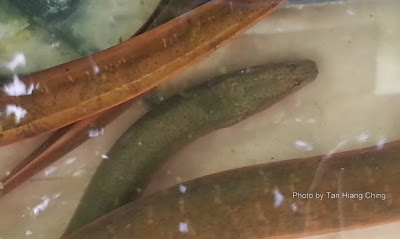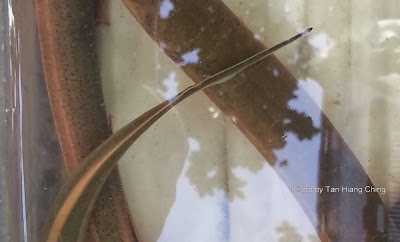Swamp Eels
Swamp eels are members of the Synbranchidae family. They are distributed in Asia, Indo-Australian Archipelago, West Africa, Mexico, Central and South America. They are recognized by having a snake like appearance with no pectoral and pelvic fins, rudimentary dorsal, anal and caudal fins, small eyes, and small gill opening.
Swamp eels are primarily freshwater fish with some species found in brackish water. They are capable of surviving short periods out of water. Most of them are bottom burrowers or cave dwellers. They are mostly nocturnal predators that eat a variety of animals including crayfish, shrimp, worms, frogs, tadpoles, and other fishes.
There are 4 genera and 23 species worldwide.
Swamp eels are primarily freshwater fish with some species found in brackish water. They are capable of surviving short periods out of water. Most of them are bottom burrowers or cave dwellers. They are mostly nocturnal predators that eat a variety of animals including crayfish, shrimp, worms, frogs, tadpoles, and other fishes.
There are 4 genera and 23 species worldwide.
Scientific Name: Monopterus albus (Zuiew, 1793)
Synonym: Monopterus javanensis La Cepède 1800
English Name: Asian Swamp Eel, Rice Field Eel, Rice Swampeel
Chinese Name | 鱼类中文名: 黄鳝 (Huángshàn), 鳝鱼 (Shàn yú)
Malay Name | Bahasa Melayu Malaysia: Belut, Belut Sawah, Belut Paya
Thai Name | ชื่อสามัญภาษาไทย: ปลาไหลนา (Plā lai nā)
Local Hokkien: Mua Hu
Main Identification Features: Body anguilliform, scaleless. Pectoral and pelvic fin absent. Eye small. Dorsal, caudal and anal fins confluent and reduced to a skin fold, without fin rays. Gill openings fused into a single aperture, located under the head.
Size: Maximum 100 cm standard length, commonly 40 cm.
Habitat and Ecology: Freshwater eel native eastern and southern Asia, genetically divided into three clades; China-Japan, Ryukyu Islands, and southeast Asian (M. javanensis). Inhabits shallow water with muddy substrate. Burrows in moist earth to survive dry season. A nocturnal predator, consuming fishes, worms, crustaceans, and other small aquatic animals. Able to change sex during life cycle.



Synonym: Monopterus javanensis La Cepède 1800
English Name: Asian Swamp Eel, Rice Field Eel, Rice Swampeel
Chinese Name | 鱼类中文名: 黄鳝 (Huángshàn), 鳝鱼 (Shàn yú)
Malay Name | Bahasa Melayu Malaysia: Belut, Belut Sawah, Belut Paya
Thai Name | ชื่อสามัญภาษาไทย: ปลาไหลนา (Plā lai nā)
Local Hokkien: Mua Hu
Main Identification Features: Body anguilliform, scaleless. Pectoral and pelvic fin absent. Eye small. Dorsal, caudal and anal fins confluent and reduced to a skin fold, without fin rays. Gill openings fused into a single aperture, located under the head.
Size: Maximum 100 cm standard length, commonly 40 cm.
Habitat and Ecology: Freshwater eel native eastern and southern Asia, genetically divided into three clades; China-Japan, Ryukyu Islands, and southeast Asian (M. javanensis). Inhabits shallow water with muddy substrate. Burrows in moist earth to survive dry season. A nocturnal predator, consuming fishes, worms, crustaceans, and other small aquatic animals. Able to change sex during life cycle.


